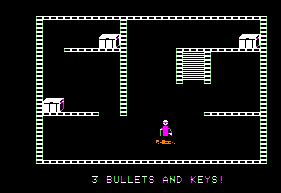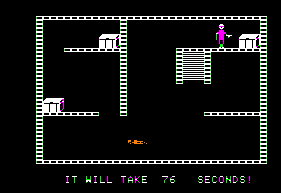Castle Wolfenstein
|
|
Castle Wolfenstein is a computer game by Muse Software for the Apple II. It was released in 1981 and later ported to the PC for DOS, to the Atari 8-bit family, and to the Commodore 64.
| Contents |
Description
Castle Wolfenstein is a combination action and adventure game. It is set in World War II during Hitler's reign of terror. The objective of the game is to traverse all the levels of the castle and find the secret war plans and escape alive.
The game features a top-down view of each room on the level, though the characters are seen upright like in a side-scroller. The player tries to traverse the levels by stealth, impersonation and sometimes killing opponents. The game is controlled via a joystick, paddles, or the keyboard. The player successfully completes the game by finding the plans hidden in a chest and escaping without being captured.
Gameplay
Upon entering the castle, where the game begins, the player is equipped with a gun and bullets. Once the player starts moving, he attracts the attention of the guards, who will try to shoot or apprehend him. He must either run from the guards, or kill them.

There are two styles of guards, the basic guards, and the SS Stormtroopers who wear bulletproof vests with "SS" plainly emblazoned on them. The regular guards are fairly daft, reacting only to the sounds of gunshots and grenades, or seeing you wandering about without a uniform. The SS guards are much smarter, and tend to chase you once you grab their attention. They usually require a large number of bullets or a grenade to kill as well.
The player can attempt to kill enemy characters (guards) in two ways, either by shooting the guard, but this expends bullets, a scarce commodity in the game, and risks raising the alarm if another guard is present in the room, or by using a grenade, which is sure to attract the attention of nearby SS guards. The guards die with a scream of, "Aieegh!" which is made even more chilling by the raspy quality of the digital sample. Once an enemy soldier is dispatched, his body can be searched for bullets, keys, grenades, and bulletproof vests.
An alternative to shooting your way out of the castle is to find a uniform (either in a chest or from a dead guard), at which point the normal guards will think you are one of them. However, the SS guards are smarter than that, and will usually notice that you aren't one of them. Typically, this means that the best strategy is to quickly obtain a uniform, and then attempt to sneak by any SS guards you run into along the way, since it is difficult (especially at higher levels) to win an outright shootout.
Guards do not always have to be killed, however. Pulling a gun on a guard usually will cause them to put their hands up, and you can frisk them for ammo, bulletproof vests, grenades, etc. The player can still choose to kill the guard at this point, but it is not strictly necessary.
Some rooms contain locked chests which can be picked and searched. Some are empty, but some contained useful items such as bullets, grenades, the war plans, uniforms, and bulletproof vests. And some contain Liebfraumilch, Schnapps, Eva Braun's Diaries, and other items that are interesting but worthless for gameplay. Edible items, when ingested, result in funny comments on their taste.
Analysis
CastleWolfensteinC64.png
Though the game's graphics are dated—and almost comical—by today's standards, they were acceptable for an Apple II game. And though the game suffered from some technical idiosyncrasies (for example, bumping into a wall caused the screen to flash random characters and generated a screeching sound), it still gained appeal. One of the main drawing points for fans was its use of digitized voices—an unprecedented technical achievement. Though the voices were scratchy and almost unintelligible because of the Apple II's limited sound facilities, they were good enough for such a break-through effect.
With an emphasis on the player trying to avoid detection for as long as possible, this game (along with its sequel) is considered an ancestor of the first-person sneaker genre of games that would gain popularity in the 1990s.
Legacy
Muse followed Castle Wolfenstein with Beyond Castle Wolfenstein which was very similar in terms of game play and appearance. The objective of that game was to kill the Führer himself.
Around the same time, an unauthorized parody called Castle Smurfenstein began circulating in the computer underground. Smurfenstein was a hacked version of the original Castle Wolfenstein; it used the same game engine, but replaced the graphics and sound assets with cartoon characters from the Smurfs TV series characters. In the Smurfenstein game, the player's objective was to escape the castle (either through the evasion or killing of smurfs) in order to "get home in time for dinner." To players familiar with both the original Wolfenstein game and the Smurfs cartoon, Smurfenstein was a hilarious spoof. Many interpreted the spoof as a sarcastic political commentary: Comparisons were made between fascist Germany and smurf society, in within which "Papa Smurf" exercised absolute power over the others. This made Papa Smurf the de-facto dictator of the smurfs.
But Castle Wolfenstein's greatest legacy was inspiring the break-through game Wolfenstein 3D by id Software. Though id's game shared a partial name with Castle Wolfenstein, its game play, plot and look and feel were vastly different. Wolfenstein 3D initiated the first-person shooter genre on the PC which is still healthy to this day. Few fans of Wolfenstein 3D know of its digital pedigree (indeed, to keep confusion to a minimum, most fans of the original game now call it "Wolfenstein 2D" to differentiate it), but, besides being an entertaining game in its own right, inspiring the seminal Wolfenstein 3D is probably Castle Wolfenstein's greatest gift to computer gaming.
External links
- MobyGame's entry on Castle Wolfenstein (http://www.mobygames.com/game/castle-wolfenstein)
- The Underdog's entry on Castle Wolfenstein (http://www.the-underdogs.org/game.php?gameid=2039)
- Lemon64: Commodore 64 version info and review (http://www.lemon64.com/games/details.php?ID=427)

